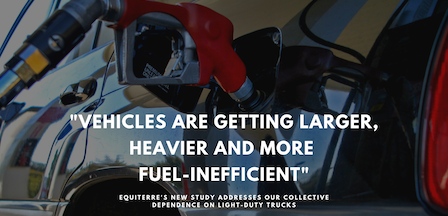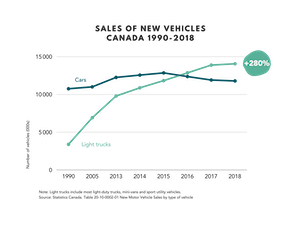Published on

Buy local, reduce waste, consume less and more efficiently... Though we have never been so concerned about what we can do to fight the climate crisis, buying energy-efficient vehicles is still not a priority concern for most Canadians. On the contrary, gas-guzzlers have never been so popular!
Between 1990 and 2018, the number of sport utility vehicles (SUVs), pickup trucks and vans on Canadian roads grew by 280%. By 2020, these light-duty trucks reached an 80% market share, a proportion that has been growing steadily for nearly a decade. It’s therefore not surprising that the transportation sector is responsible for a quarter of Canada's greenhouse gas emissions and almost half of Quebec's!
vans on Canadian roads grew by 280%. By 2020, these light-duty trucks reached an 80% market share, a proportion that has been growing steadily for nearly a decade. It’s therefore not surprising that the transportation sector is responsible for a quarter of Canada's greenhouse gas emissions and almost half of Quebec's!
"If we want to meet our climate targets, it has become imperative that we redirect consumers' transportation choices."
Understanding what’s behind the trend
In an effort to better understand the growing preference of Canadians for gas-guzzling vehicles and to propose possible solutions to reverse the trend, Équiterre collaborated with Polytechnique Montréal, HEC Montréal and the CIRANO research group on a broad study. The study covers a range of topics, including the role of advertising, the socio-economic factors that have affected the shift in vehicle types, purchase motivations, public policies, and more.
Unregulated advertising for oversized vehicles
The first report from this study illustrates the significant role that automotive advertising plays in the proliferation of light-duty trucks.
1. Problematic advertising messages
An analysis of the content of light-duty truck advertising indicates that many advertisements hinder consumers' ability to make informed decisions:
- The vast majority of ads use nature or its attributes to sell light-duty trucks (68%);
- The ads very often feature attractive financing terms, making light-duty trucks seem more affordable (special offers, instalments, low down payments, low or zero interest, deferred payments, etc.), but the full price of the vehicle is shown in less than half of the ads.
- The ads sometimes highlight the energy-efficiency aspects of the promoted vehicle but fail to mention fuel consumption and/or CO2 emissions.
2.Omnipresence of automotive advertising because of huge investments
Have you gone a day recently without being exposed to a car ad on the web or elsewhere? It's not likely! In 2018, the automotive sector was the largest spender on digital advertising in Canada with an estimated $1.6 billion, or 21% of total investments.
And if you pay attention to the ads in Canadian newspapers and magazines, you'll see that light trucks are featured far more often than small cars. In 79% of the advertisements surveyed, they are promoted either primarily or exclusively.
3.An underregulated sector
The automotive sector has almost infinite freedom to promote oversized vehicles, subject to few legal constraints. In other countries around the world, regulations are much stricter: there are requirements to display fuel consumption, restrictions on the representation of nature or the use of terms such as "environmental protection," etc.
So how do we solve this problem?
"First and foremost, we must identify the proliferation of SUVs and other gas-guzzlers as a public health and safety issue, like we did with smoking, speeding and advertising directed at children," explains Andréanne Brazeau, Équiterre’s Mobility Analyst.
Governments therefore have a major role to play: they must align the regulatory framework that governs automobile advertising with the country's climate and electrification targets.
Équiterre’s recommendations to the federal government:
- Recognize the rise of light-duty trucks as a public health and safety issue;
- Establish an independent, multi-sectoral panel of experts;
- Draw on existing advertising restrictions as a model;
- Gradually increase the regulations on automotive advertising and spending;
- Undertake additional campaigns to promote sustainable mobility.
To learn more about the results of the report:




